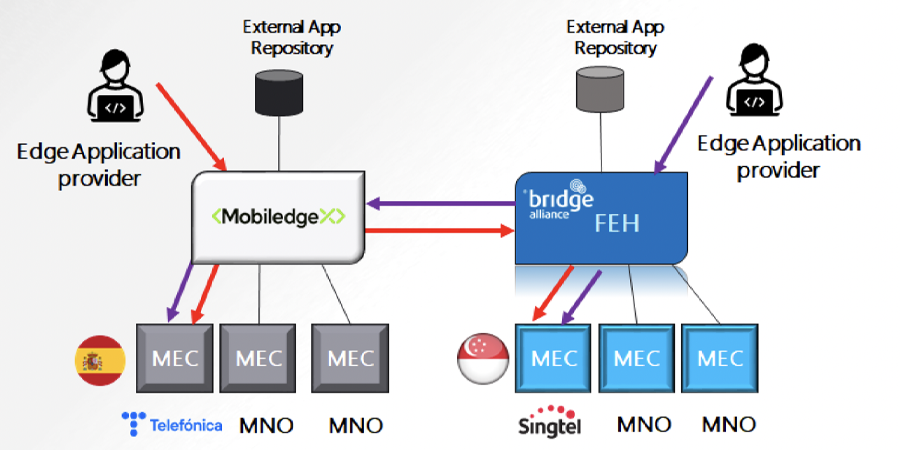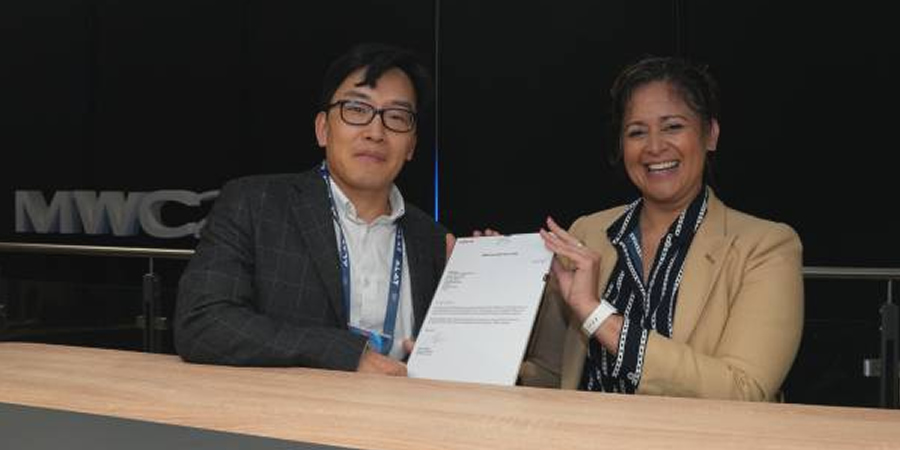
In a world first, Singtel, Bridge Alliance, MobiledgeX and Telefonica have successfully achieved an interconnection between two heterogenous multi-access edge computing (MEC) platforms as part of a GSM Association (GSMA) Foundry Telco Edge Cloud trial. The hub-to-hub interconnection between the Bridge Alliance Federated Edge Hub (FEH) and MobiledgeX Edge-Cloud platform could allow edge applications to be deployed across different edge platforms and regions served by each hub.
Singtel’s MEC and Telefonica’s MEC are connected by FEH and MobiledgeX Edge-Cloud platform respectively. With the interconnection, Singtel’s customers will be able to deploy edge applications on Telefonica’s MEC and vice versa, enabling multi-market services delivery across an extended geographical footprint, including Asia and Europe.
Customers, developers, and partners can discover, as well as order cross-regional edge resources and deploy applications through a unified interface, ensuring a uniform experience across different networks and markets in these regions. Previously, interconnections were performed between operators on a one-on-one basis, making it difficult to scale the edge coverage.
Dr Ong Geok Chwee, CEO of Bridge Alliance, said, “We’re delighted to achieve this industry-first milestone with MobiledgeX and Telefonica. The implication of such hub-to-hub interconnections is that our member operators’ enterprise customers will be able to offer exciting data-intensive and low latency services in markets beyond our Asian footprint. We believe that this is only the beginning of more cross-regional edge deployments in the industry, which will occur as more of our member operators come on board our FEH, and as more trials between different edge hubs/aggregators are established. We welcome more edge hub partners on board.”
Michael Lochead, SVP of product for MobiledgeX said, “The true promise of edge computing hinges on seamless developer access for high-performance applications that can take advantage of global reach. Today’s announcement represents another major leap toward this goal, demonstrating that operators in disparate regions can choose the edge computing platform that best fits individual market needs while still easily achieving worldwide reach. We are proud to continue advancing edge compute possibilities with our operator partners as meaningful edge service rollouts are prepped for 2022 and beyond.”
Dennis Wong, VP of enterprise 5G and cloud, Singtel said, “We’re excited to be part of this breakthrough that thoroughly exploits our engineering innovation. The FEH hub-to-hub interconnection integrates with Singtel’s Paragon platform, complementing and amplifying its capabilities, benefiting our ecosystem partners and customers who have global deployment needs. Through the hub-to-hub interconnection, developers will be able to deploy applications globally on the MEC while using Paragon to manage services and operations through a single local point of access, transforming the way enterprises of the future manage and orchestrate networks, MEC, cloud, applications and operations. This will super-charge the innovation and deployment of next-generation applications such as virtual reality and metaverse that need high processing power, high bandwidth connectivity and low latency.”
Juan Carlos Garcia, senior VP of technology and ecosystem, Telefónica, said, “Federating regional edge hubs is key for the success of the telco edge cloud. This is a crucial achievement, not only for Telefonica and Singtel but also for any operator served by Bridge Alliance’s Federated Edge Hub or MobiledgeX worldwide, extending its potential footprint significantly. With this paramount milestone, we pave the way for the future edge cloud continuum that we envisage as industry, and provide a seed for the industry to agree on a common interface and the standardization of the federation APIs for operators and other service providers.
The interconnection was achieved during a trial facilitated by the GSMA Foundry Telco Edge Cloud (TEC) project, an initiative that brings the industry together to collaborate around a number of pre-commercial trials of Telco Edge Cloud capabilities with app developers and service providers sponsored by the industry partners and supported by MNOs. Learnings from the trials are shared with the TEC community via the GSMA TEC Forum, a body that guides development in the TEC space and promotes compatibility, portability and interconnection among telco deployments. Interoperability and resource-sharing in edge computing are vital to enable effective interconnections like the one between the Bridge Alliance FEH and MobiledgeX Edge-Cloud.
Henry Calvert, head of networks, GSMA, said “At the heart of unlocking the full power of connectivity, is federation, shown before, now we, as a collaboration, have shown edges can be connected between different hubs, creating global reach. Join the hubs, lets connect those edges.”
The Bridge Alliance FEH is a platform that interconnects the MEC of its member operators, allowing easy onboarding of their respective edge platforms, thus enabling them to discover and order their counterparts’ edge compute resources in markets across multiple geographies via a one-stop-shop. Bridge Alliance had previously completed a proof of concept for the edge cloud federation involving Singtel and SK Telecom MEC platforms in Singapore and South Korea respectively. Meanwhile, MobiledgeX’s federation capabilities enable mobile operators using its edge-cloud platform to interact with other operator platform instances, providing developers with larger edge reach and operator capabilities.







